-
Car Reviews
- Car News
-
Car Comparisons
Latest comparisons
- Chasing Deals
Larger, cheaper, quicker: loveable Czechian go-fast seven-seater lifts its game in all of the right places
To date, in Kodiaq RS, Skoda has melded seemingly contrary disciplines of big, seven-seat practicality with crisp, drive-focussed performance so confidently that the experience easily transcends its on-paper concept.
And it’s a concept that swerves so far away from its Hyundai Santa Fe, Kia Sorento and Mazda CX-80 counterparts that it probably deserves its category.
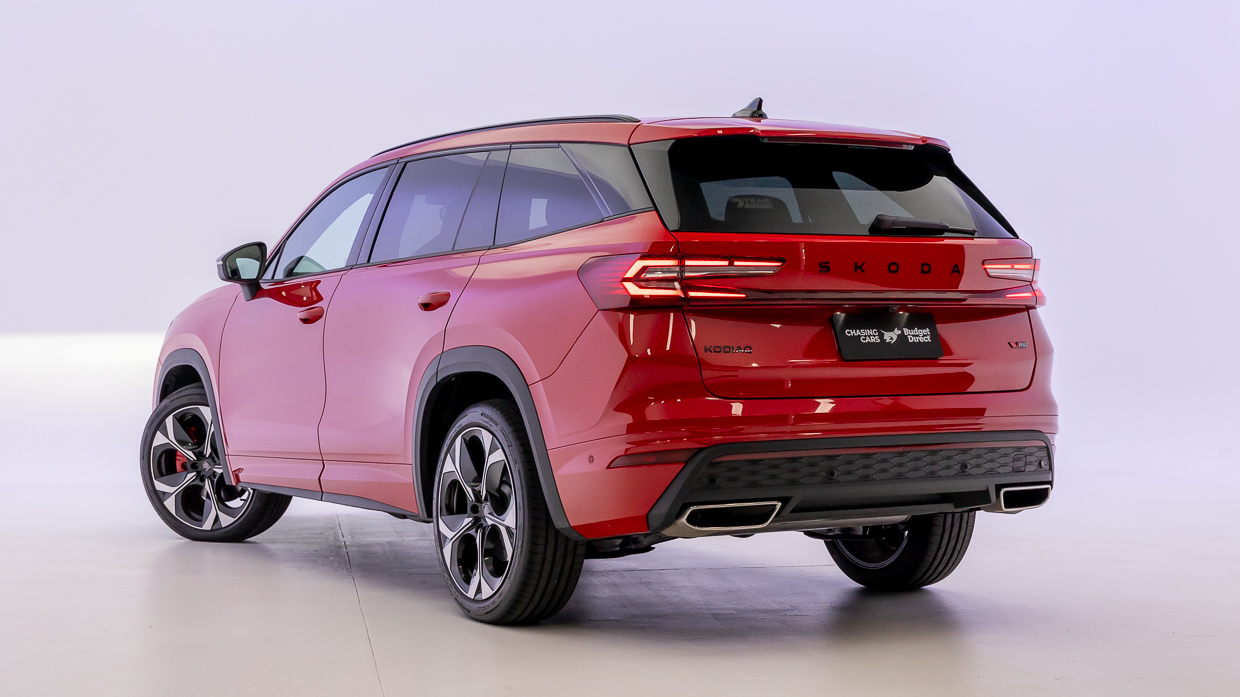
Diesel was dropped for the Octavia RS turbo-petrol power unit back in 2022, a recipe revived here in the new gen-two ‘large’ Kodiaq reboot that launched earlier this year in milder trims and return now in RS – for ‘rally sport’ – guise, leaning harder into the three ingredients key to its appeal.
Kodiaq RS is now larger. And quicker. And cheaper. All of which ought to bolster the fortunes of a breed that scored a resounding 8.5/10 critical rating three years ago at Chasing Cars, and resonates with buyers so much that half of all Kodiaq buyers have stump up for this go-faster RS version, a trend its importer forecasts is set to continue.

What’s new? All of the larger, roomier, smartly packaged form we covered off in detail in our first drive of the recent gen-two debut, packing a more-powerful (+15kW) 195kW and 400Nm version of VAG’s evergreen ‘EA888’ 2.0-litre turbo petrol four, with a sizeable list of new or upgraded features and spec (more below).
But the key to this RS formula is not merely to add excess. Indeed, the engine shared with the likes of the Octavia and Volkswagen’s Golf GTI is outpunched by Hyundai’s larger turbo 2.5-litre SUV donk (at 206kW and 422Nm), yet the Skoda (6.3sec 0-100km/h) is a significantly hotter (versus 7.9sec for Santa Fe) performer.
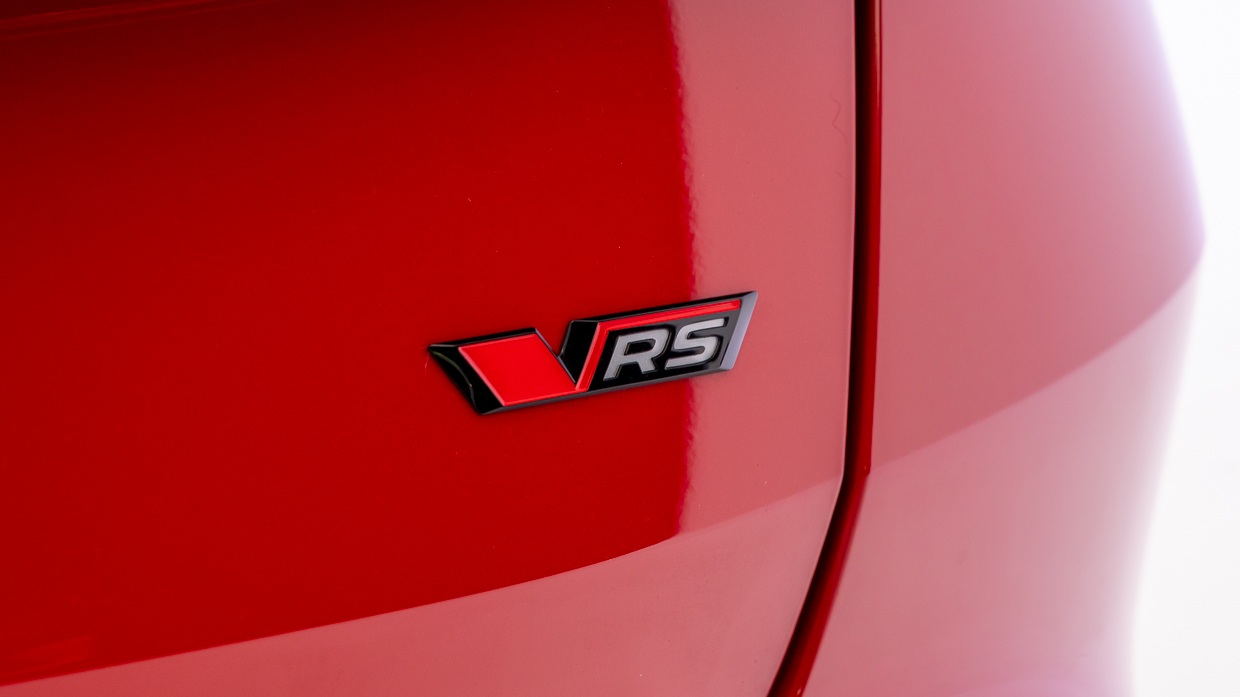
What’s served Kodiaq RS so well to date is both what it’s got <and> what it does with it, amalgamating a Jekyll and Hyde duality that’s as accomplished as its rivals at seven-up family hauling comfort yet a lofty benchmark for one-up, backroad fun factor.
It’ll be interesting to see how more of the former in this new gen-two guise might impact the latter as a matter of compromise.
The gen-two Kodiaq RS 2.0 TSI 4×4, to give it its full name, lists for $69,990, or $76,990 driveaway. That’s around $600 cheaper than the outgoing gen-one.
Logical seven-seat cross shops include Hyundai Santa Fe 2.5T Calligraphy ($72,750), Kia Sorento GT-Line ($66,290) and Mazda CX-80 G40e GT ($67,816), all prices before on-roads.
There’s also the mechanically related Volkswagen Tayron 195TSI, which runs a bit higher at $73,490 before on-roads.
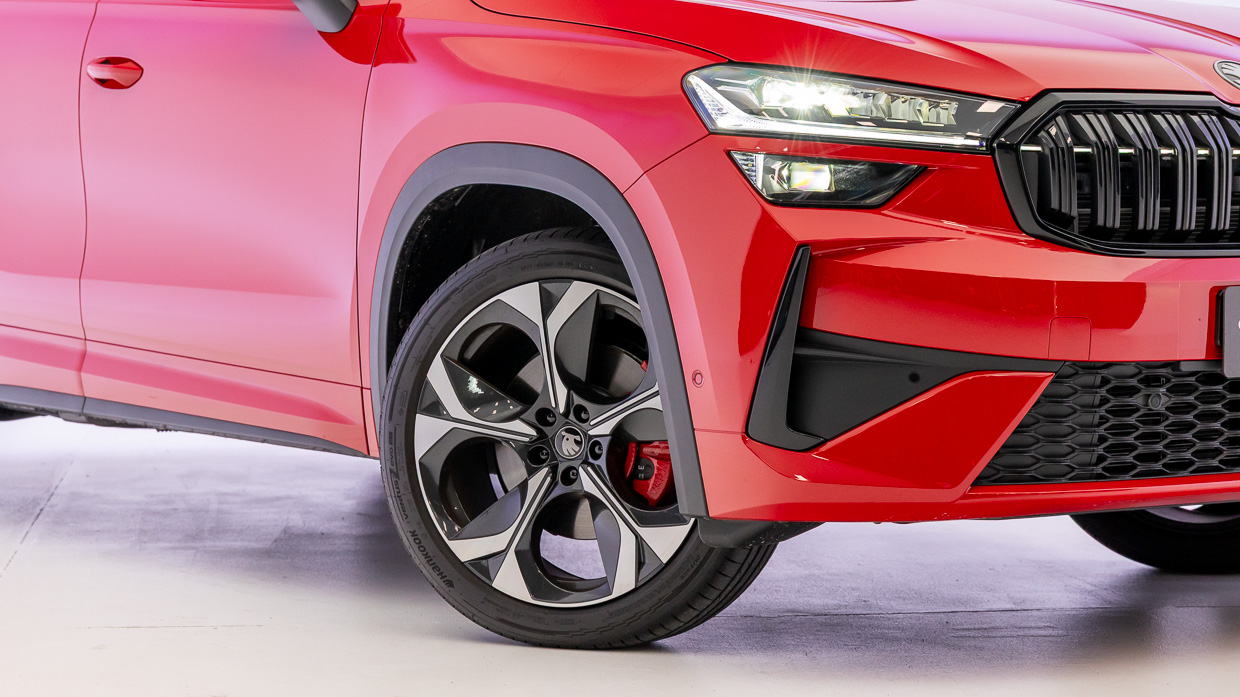
Added specification of the new gen over the old includes:

Largely carryover standard specifications include:
The Kodiaq RS comes in six metallic colours plus one pearlescent hue, including Brilliant Silver, Moon White, Race Blue, Graphite Grey, Black Magic and Steel Grey, with the only cost option the hero colour Velvet Red ($770). A panoramic glass roof is optional at $1900.
Kodiaq RS’s transition from (176kW/500Nm) diesel to the facelift’s (180kW/370Nm) Octavia RS-aligned 2.0L turbo-petrol brought sprightlier performance (7.0sec to 6.6sec 0-100km/h) back in 2022.
But the newcomer’s lift to 195kW and 400Nm for its evergreen EA888 makes gen two the fittest yet.

Result? A drop to 6.3sec for the 0-100km/h sprint. Sure, it’s not the quickest barge-sized land missile out there, but the likes of Audi’s turbo-V8 SQ7 (4.1sec) leaves little change from $200K on road…
The RS is a fair boost above the (140kW/320Nm) Kodiaq Sportline if short of Hyundai Santa Fe’s 2.5T engine (206kW/422Nm), but the fact that the Czech SUV is 1.5sec swifter demonstrates the cut of its surprisingly lithe jib that translates in one very fun-to-dive nature.
Part of it is the crispness of the seven-speed dual clutch gearbox. And part of it the all-wheel drive system, which fits an electro-mechanical multiplate clutch that shuffles torque to the axles and wheels that need it most with impressive precision.
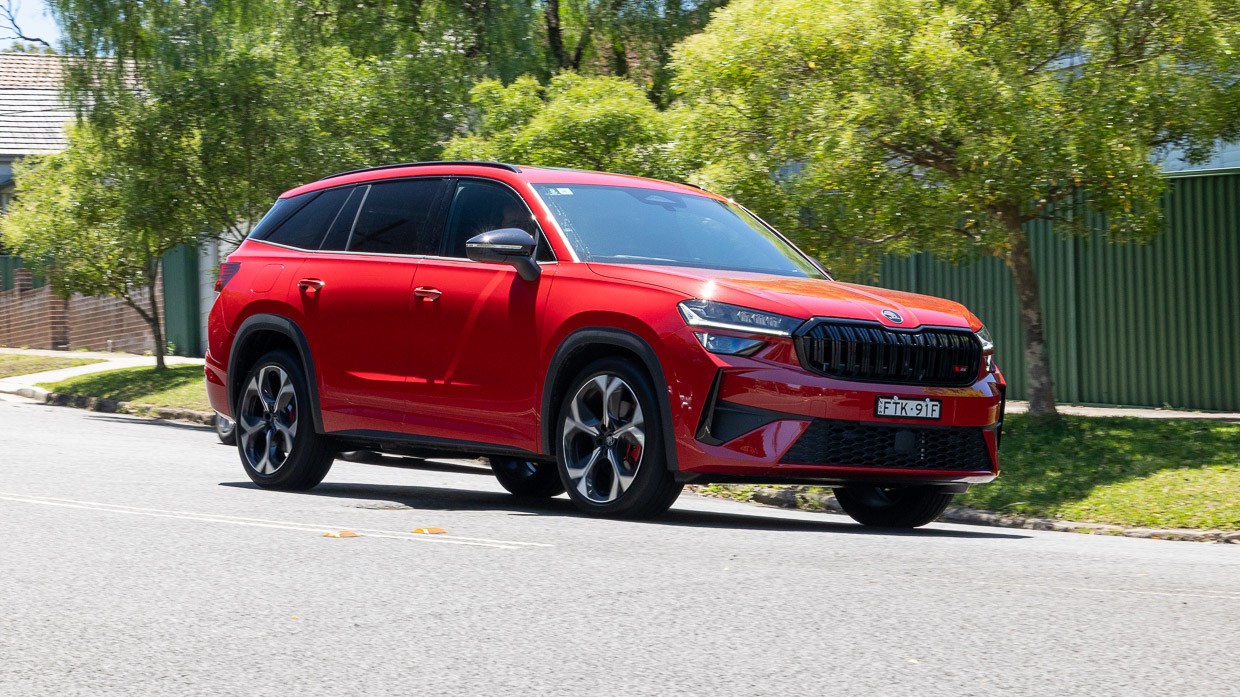
Unlike Korean rivals, the Kodiaq RS brings progressive (variable rack ratio) steering and VW Group’s widely deployed 15-way adaptive damping, the system here an updated Dynamic Chassis Control Plus dual-valve design: one valve for compression, the other for rebound.
It’s said to improve pitch and roll control – without the complexity and weight penalties of 48-volt anti-roll bar – but, whatever the case, the Czech SUV’s systems conspire to convincing oh-so-jumbo-hot-hatch vibes when you uncork the seven-seater across a twisty back road.
In Sport mode, the engine (or synthesis hereof) growls, the powertrain response heightens to the driver’s inputs and the SUV becomes taut and sharp. In fact, the go-fast Kodiaq gets toey enough that it’s a little too hairy chested for casual around-town duties.

But punting between corner apices, the precision (and weight) of the steering is confidence inspiring, paired beautifully with an all-wheel drive system that sends enough torque to and across the rear for keen chassis rotation, without excessive tail-out histrionics.
It grips up well, too, as the DCC Plus damping returns a taut enough stance to yield fine body control, if with enough compliance and precise wheel control to maintain adhesion across mid-corner bumps. In fact, its middling ‘seven’ setting is really set and forget – no need to chase a damper setting of the 15 available.
Back-off into Normal mode and the Kodiaq RS settles down noticeably, a proper Jekyll to counter its Hyde.
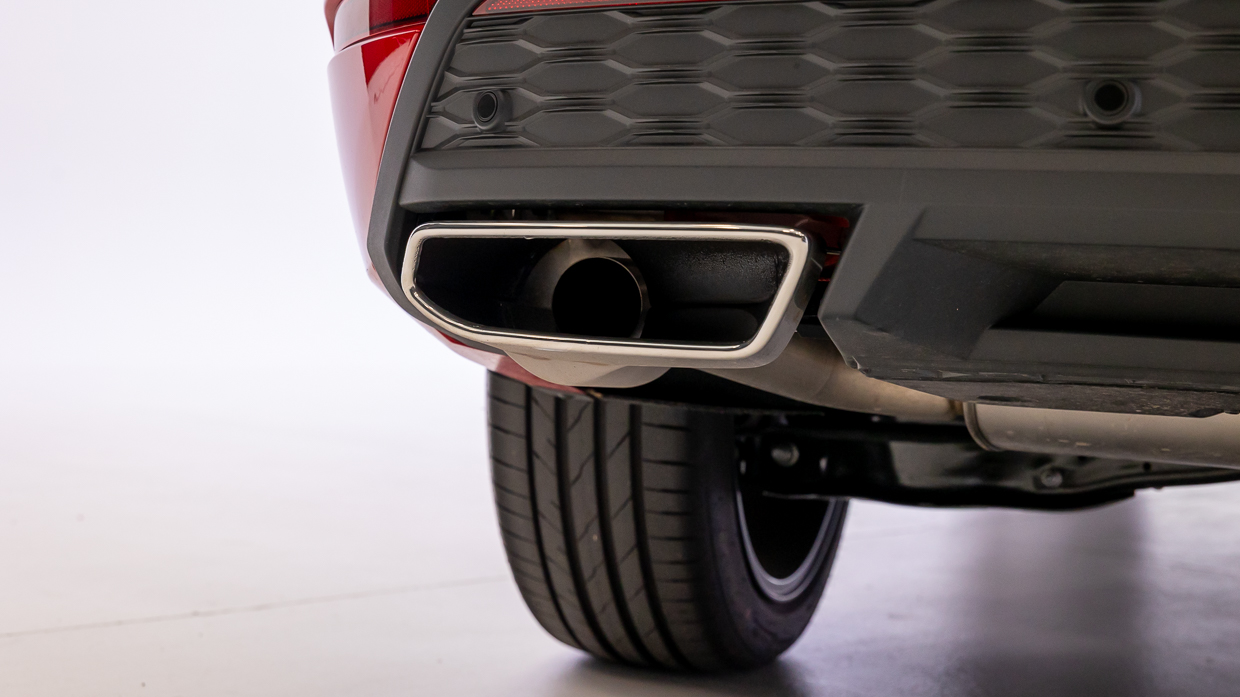
The engine becomes much quieter, the powertrain is less frenetic, and the ride is soft enough wherever the dampers set their Normal default though, again, you can easily tweak that conditions, taste and payload depending on trip requirements.
It does the comfort SUV thing well, if with an everpresent sheen of sportiness to its character.

One downmark on the road is that – if you really nitpick – the dual-clutch transmission isn’t quite as polished as some torque converter design at low speed and during stop-start traffic. It’s good, but not seamless.
Another is that this particular example is prone to a few gremlins with its driver safety systems. When they’re all in play, they seem to work transparently and faultlessly – the only electric aid we were compelled to turn off is the abrupt stop-start system, easily from the media homescreen.
The added 60mm of overall length, that bumps Kodiaq into certifiably large categorisation, translates to extra cabin space, though it does feel a little cosier than the Hyundai Santa Fe and Kia Sorento it now competes with.
Partly this is down to the design, and the ‘black’ – actually dark grey – theme that robs a sense of airy ambience compared with lighter-coloured schemes available elsewhere in the Kodiaq line-up. And part of it is that the Skoda’s cabin feels narrower than the Koreans’.
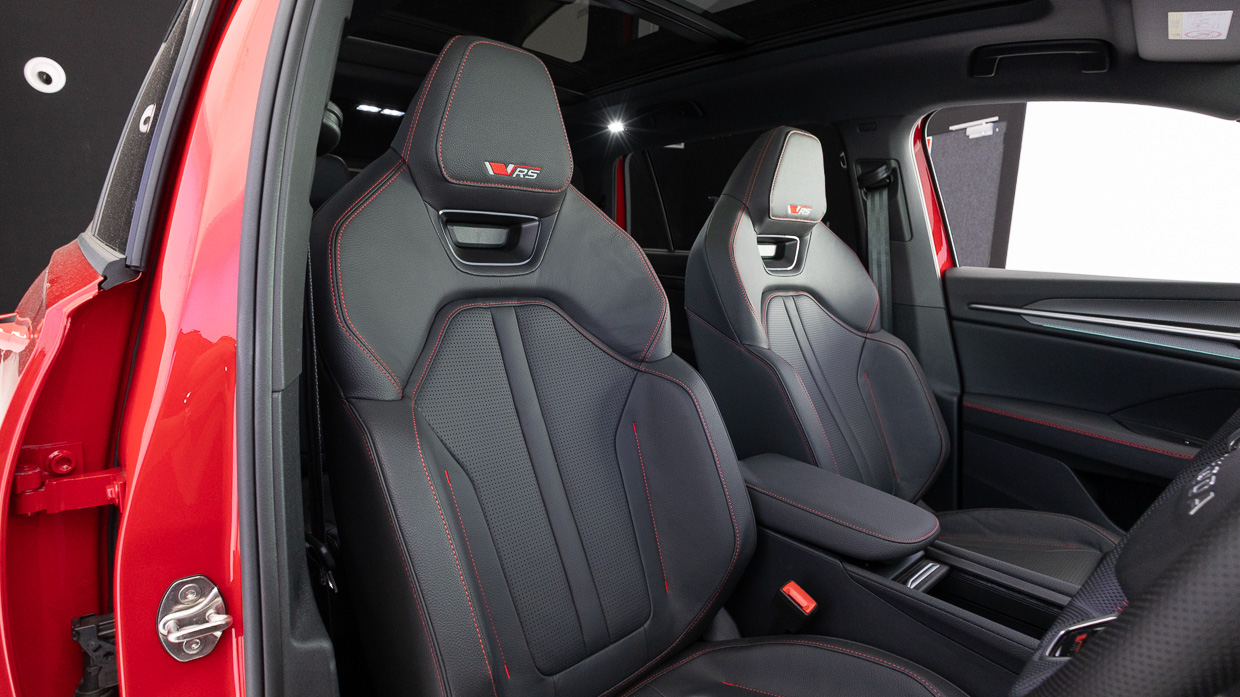
It’s conspicuously sporty in vibe, most down to the so-called Sport Comfort seat design with integrated head rest, though much of the go-fast effect is in the so-called RS Sport look – lots of red stitching and metal-look plastics, mostly – because the luxury-leaning Sportline variants get very similar pews.
They’re fully electric on both sides, which is nice, but the perforated leather-appointed trim isn’t quite as lush and welcoming as the semi-suede and leatherette seat in the small, $10K-cheaper Enyaq 85 Sportline stablemate. The trim craft is also a little wavy in areas.
Bar lacking quite enough reach adjustment of the Skoda-block flat-bottom wheel, the sport-executive vibes are convincing, driver-centric enough without completely masking that you’re at the helm of a plus-sized SUV. The neat angular door handles and air vent motifs are pretty classy.
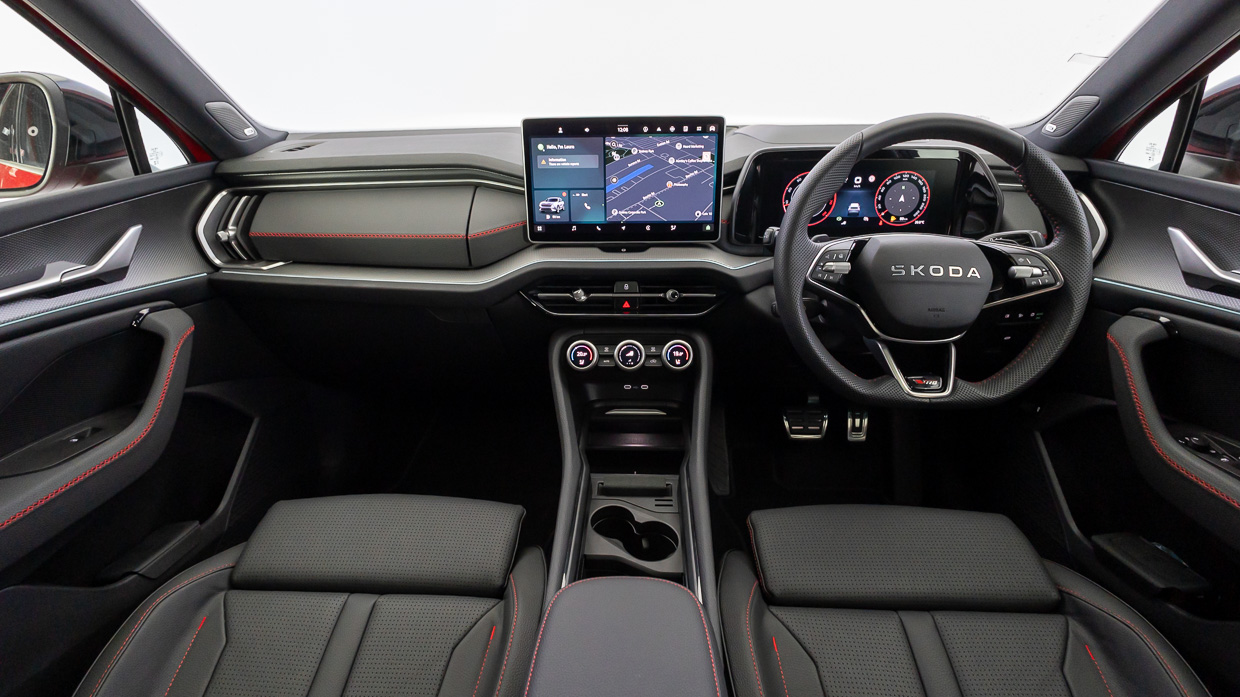
The new Kodiaq cabin design is a big leap forward over the old generation, part of it the diverse material choice, with much of it nicely tactile and soft to touch. Elsewhere, this gen-two adds extra niceties over the old first gen, such as a colour head-up display and steering wheel heating.
It’s techier, too. A new column-mounted transmission selector keeps the console clean for stuff like dual phone charging, which is ventilated so phones don’t cook under the 15-watt charging power. It’s flacked by dual cupholders that can split themselves into four repositories.
Above that are these very tricky full-colour Smart Dials for very conventional HVAC control for the upgraded three-zone system. Here, the centre dial toggles between climate control, audio volume and a setting that allows easy drive mode changes on the fly. Very cool.
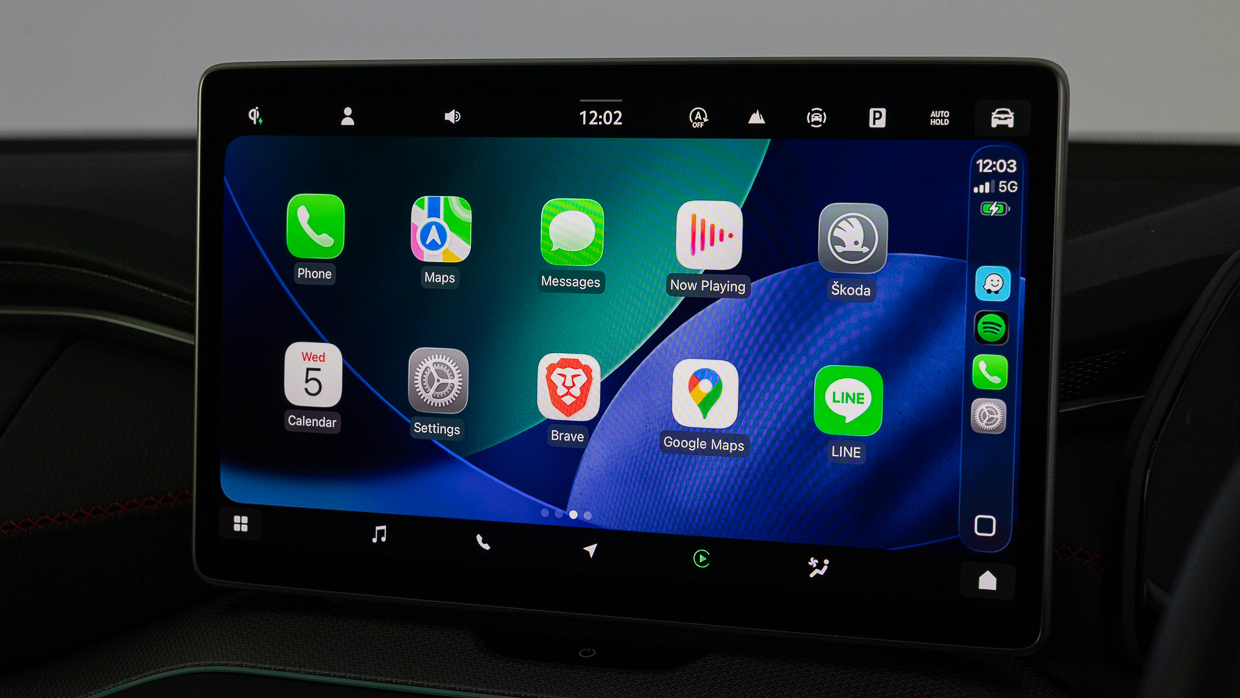
The 13.0-inch media touchscreen that’s a whopping four-inches larger, corner to corner, than the old system, and is typical of the new VAG breed: fast and easy to use, with key shortcuts conveniently located on the homescreen.
DAB+ and a 13-speaker Canton sound are two nice upgrades over its predecessor, while Apple CarPlay and Android Auto are both wireless.
You now get five 45-watt USB-C outlets, including, curiously, one in the rear-view mirror, and storage is pretty decent, including the flocked bins and a glove with neat twin-lid design.

Nifty touchscreen fingerprint eraser, neat extending door bumper pads and, of course, the umbrella in the driver’s door to keep you dry, are nice ‘Simply Skoda’ touches for a rig that gets the basics right, such as large flock-lined door bins.
Row two is where Kodiaq feels noticeably cosier than a Santa Fe, mostly in width door to door where three adults are going to be something of a squeeze. The plastic oddment bin and cupholder array at the floor, which is press-fit and easily removable, feels a little ad-hoc.
But the rear bench is split and can slide and tilt to tune in maximum comfort as a five-seater and balance knee room well enough with occupants in all three rows. The seat design is quite comfortable, though the seatbelt clasps sunk into the seat base do tend a jab into your thigh a little.


But it lays on the amenities: a dedicated third-zone climate control with seat heaters, dual USB-Cs, phone cubbies in the seatbacks and roll-up sunshades are all pars for the RS course.
Row three is tight: nowhere near as adult-friendly as a Santa Fe, and perhaps best reserved for kids and as emergency adult seating for short trips.

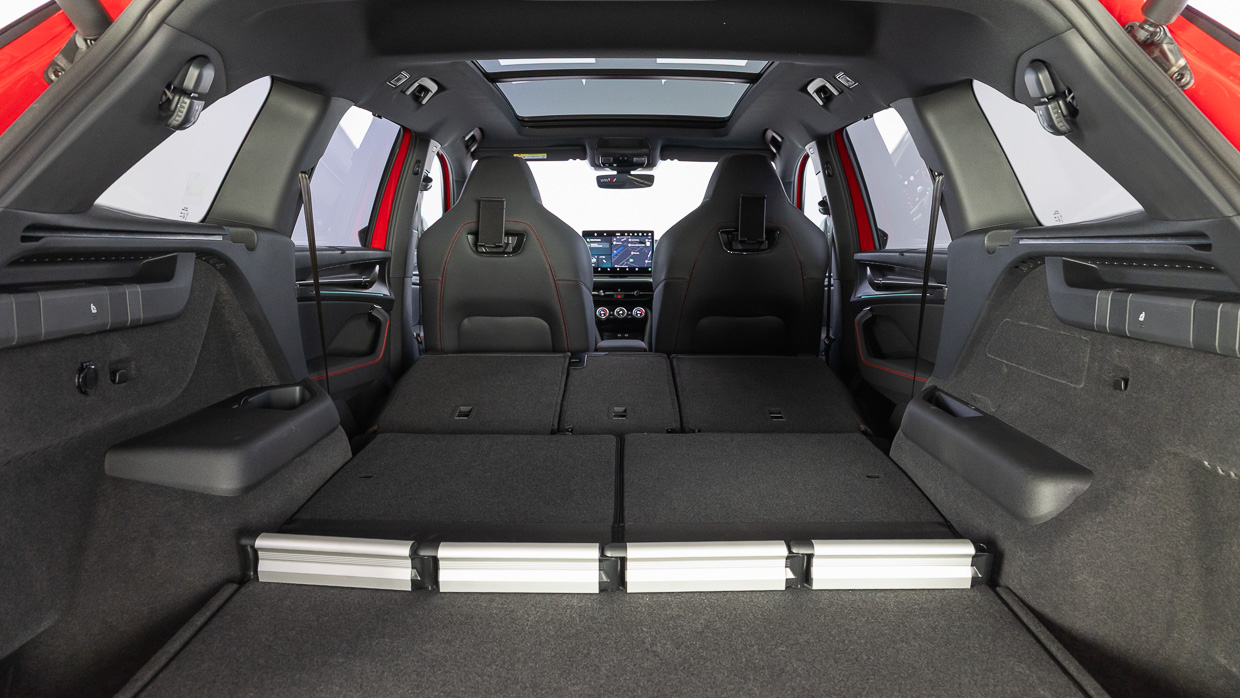
The kick sensor tailgate opens to reveal a pretty handy 289L of boot space, including one of Skoda’s nifty doo-dads: a metal guard rail that ‘Velcros’ itself to the carpet to wedge your luggage in to prevent it from flying all over the place.
Handy levers drop row two to liberate 794L of load space, while converting the Kodiaq to a two-seater liberates a whopping 2035L. Skoda claims the Kodiaq out-spaces key mainstream rivals for volume in the three seating configurations.
There’s a long, long list of active features in this gen-two Kodiaq and almost all of them have been upgraded or newly introduced.
Features fitted as standard include:
The gen-two newcomer scored five stars under the latest ANCAP protocols, too, based on Euro NCAP testing, a score set to hold for another five years.
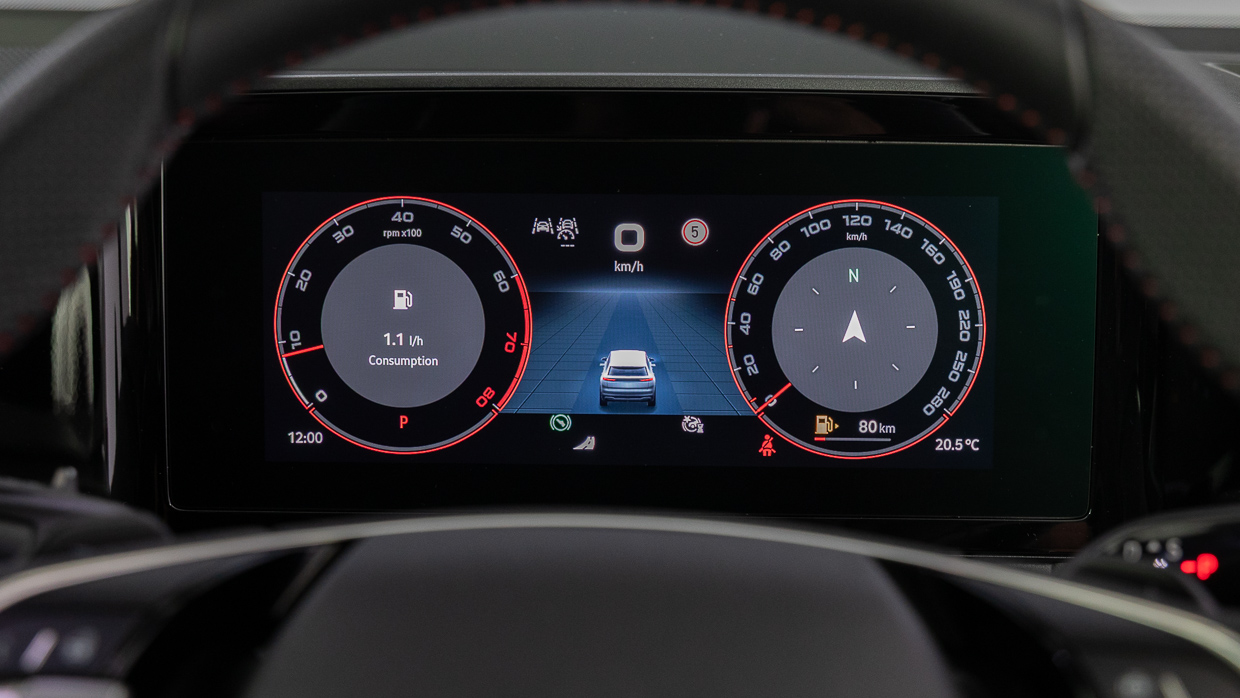
Assessment scores were 89 and 87 percent respectively for adult and child occupant protection, 82 percent for vulnerable road user protection and 81 percent for safety assist.
The ADAS systems are unobtrusive and proved functionally sound during our week with the SUV. However, as mentioned, our example was plagued by some sort of gremlins that would shut down groups of active features, for short periods of time, sporadically.
Servicing costs? It’s $3000 for a five-year servicing pack, or $700 cheaper than the old generation, with typical 12-month and 15,000km intervals.
Warranty is seven years of unlimited kilometre coverage.
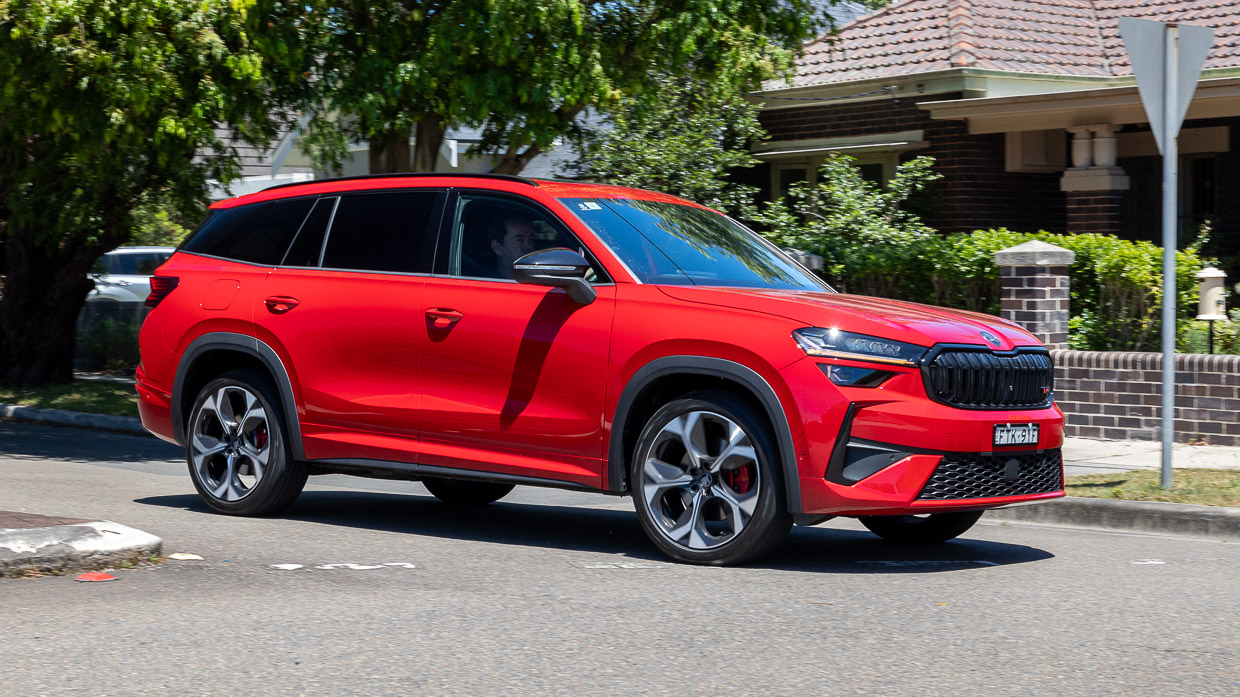
Fuel economy? Skoda claims 8.1L/100km of combined fuel consumption and, what do you know, that’s exactly what we saw in our week with the Kodiaq RS.
And it’ll run on 95-RON premium or the generally much cheaper E10.
For many new car buyers, the notion of a seven-seat SUV that drives like a jumbo hot hatch might sound like an answer to a question nobody asked. But given that, historically, half of all Kodiaqs sold in Australia were go-fast RS versions, it’s certainly an answer a lot of SUV owners like and want.
And despite the seemingly conflicting aspirations, the Kodiaq RS nails the landing on both.

It’s a very good three-row SUV. Perhaps not quite as roomy as some rivals, but there’s no less space or comfort compared with the regular Kodiaq variants. It’s easy to drive and to live with, even if you never drive it hard.
Once you do uncork the RS, it’s genuinely fun and genuinely capable. As a proper driver’s car, there’s certainly no other attainable three-row SUV out there that can match the Skoda.
And there’s a lightness to the Kodiaq RS that you don’t get in big-dollar, high-performance SUV such as the Audi SQ7 which are quite a bit quicker but should be for well over twice the price.
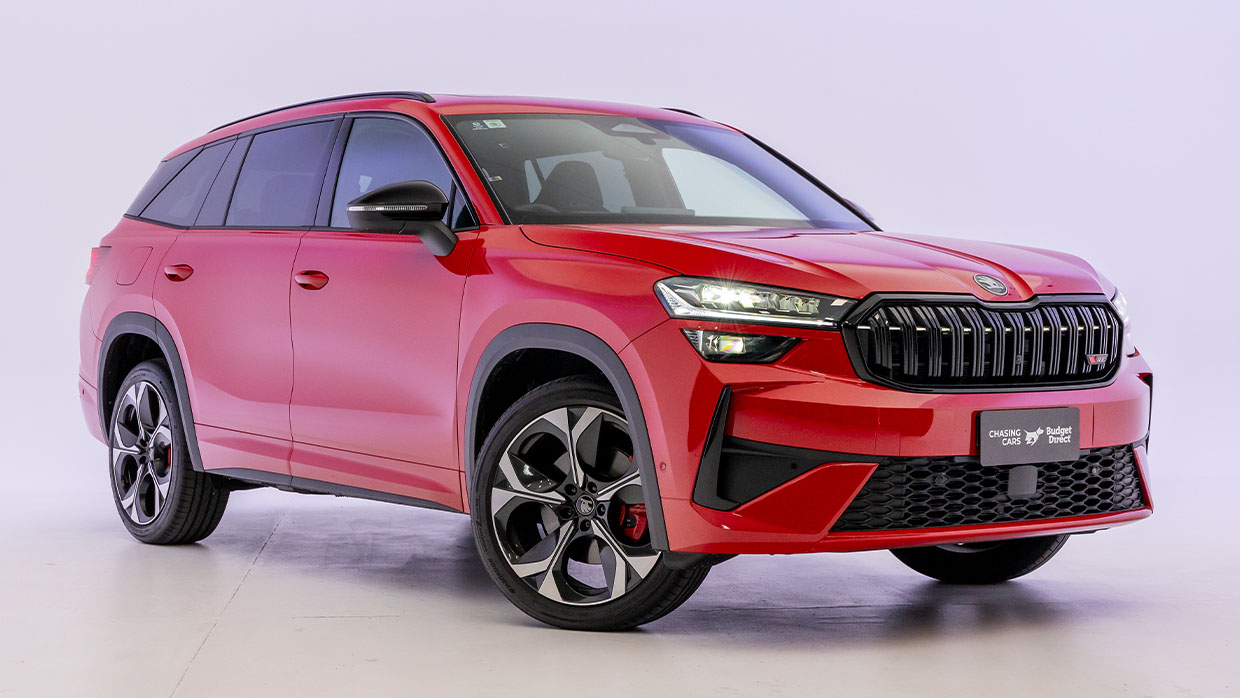
Larger. Cheaper. Quicker. This new gen-two takes what made the first-gen great and lifted its game further in areas that matter most to buyers who are drawn to it.
Skoda is enjoying a bit of a purple patch right now with some great new and updated models, such as the updated Enyaq electric midsize SUV. And the Kodiaq RS is one that is highly recommended if you’re shopping for a seven-seater, whether you’re after the go-fast performance or not.
About Chasing cars
Chasing Cars reviews are 100% independent.
Because we are powered by Budget Direct Insurance, we don’t receive advertising or sales revenue from car manufacturers.
We’re truly independent – giving you Australia’s best car reviews.
The estimate provided does not take into account your personal circumstances but is intended to give a general indication of the cost of insurance, in order to obtain a complete quote, please visit www.budgetdirect.com.au. Estimate includes 15%^ online discount.
^Conditions Apply
Budget Direct Insurance arranged by Auto & General Services Pty Ltd ACN 003 617 909(AGS) AFSL 241 411, for and on behalf of the insurer, Auto & General Insurance Company Limited(ABN 42 111 586 353, AFSL 285 571).Because we don’t know your financial needs, we can’t advise you if this insurance will suit you. You should consider your needs and the Product Disclosure Statement before making a decision to buy insurance. Terms and conditions apply.
Indicative quote based on assumptions including postcode , 40 year old male with no offences, licence suspensions or claims in the last 5 years, a NCD Rating 1 and no younger drivers listed. White car, driven up to 10,000kms a year, unfinanced, with no modifications, factory options and/or non-standard accessories, private use only and garaged at night.
^Online Discounts Terms & Conditions
1. Discounts apply to the premium paid for a new Budget Direct Gold Comprehensive Car Insurance, Third Party Property Only or Third Party Property, Fire & Theft Insurance policy initiated online on or after 29 March 2017. Discounts do not apply to optional Roadside Assistance.
2. Discounts do not apply to any renewal offer of insurance.
3. Discounts only apply to the insurance portion of the premium. Discounts are applied before government charges, taxes, levies and fees, including instalment processing fees (as applicable). The full extent of discounts may therefore be impacted.
4. We reserve the right to change the offer without notice.